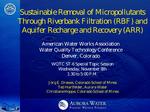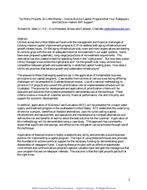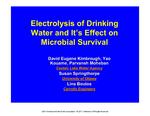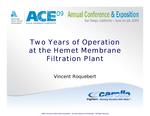Provide PDF Format
AWWA WQTC64190
- Sustainable Removal of Micropollutants through Riverbank Filtration (RBF) and Aquifer Recharge and Recovery (ARR)
- Conference Proceeding by American Water Works Association, 11/01/2006
- Publisher: AWWA
$12.00$24.00
This slide presentation outlines a study on the sustainable removal of micropollutants through riverbank filtration (RBF) and aquifer recharge and recovery (ARR). Aurora's Test Plan for NaturalPurification includes:determine the removal of emerging organicmicropollutants during RBF and ARR;field-scale studies;laboratory-scale column studies;evaluate fate and transport as well as keyremoval mechanisms for individualcompounds;adsorption vs. biodegradation; and,removal rates under different redox conditions(oxic, anoxic). The RBF Well was Operated and Monitoredfrom December 2004 to June 2006 with these results:TOC, turbidity, nutrients(e.g., nitrogen, phosphate);Organic micropollutants includingPharmaceutical residues (e.g.,analgesics, anti-inflammatories,antiepileptics, lipid regulators,antibiotics), personal care products and othertrace organics (e.g.,antimicrobials, chlorinated flameretardants), endocrine disruptors (e.g., steroidhormones, bisphenol A), andemerging contaminants (e.g.,NDMA). Demonstration Testing of AquiferRecharge and Recovery included:feedwater from RBF site; 25 monitoring wells;3 nested piezometer wells;4 production wells;sampling: bulk parameters (TOC,pH, conductivity, nitrate,ammonia), andorganic micropollutants(PhACs, FlameRetardants, EDCs,Pesticides). Pilot Scale Soil Column Test Results includingOther Acidic Drug Compounds such as Ibuprofen,Naproxen, Diclofenac showed that:no removal was observed under abioticcolumn experiments;no adsorption onto soil;removal below detection limit under bothoxic and anoxic column experiment; and,biodegradation. A summary of RBF and ARR Performance in Aurora'sMultiple Barrier Purification System shows that:RBF exhibits consistent removal of TOC,independent from stream flow and season;micropollutants in column experiments weredegraded slower under anoxic as compared to oxicconditions;lab-scale findings and field monitoring suggestefficient and sustainable removal of vast majority ofmicropollutants during RBF; and,findings indicate that NDMA is biodegradable inless than 6 days under anoxic conditions. Includes figures.
Related Products
AWWA ACE63199
So Many Projects, So Little Money - How to Build a Capital Program That Your Ratepayers and Decision..
$12.00 $24.00





